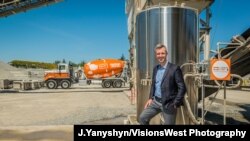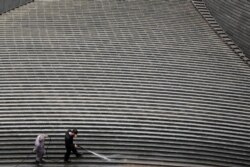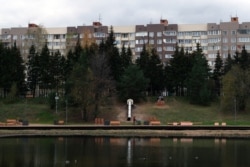It's literally the foundation of modern life.
A slab of concrete underlies nearly every permanent structure on Earth. Concrete blocks are a basic unit of construction worldwide, with 1 trillion being manufactured yearly by 2027.
But concrete, the most abundant human-made material in the world, is also one of the largest sources of planet-warming carbon dioxide. Concrete manufacturing is responsible for between 4% and 8% of the world's carbon dioxide emissions, ranking third after fossil fuel burning and deforestation.
And demand for the ubiquitous building material is expected to grow significantly to accommodate a growing population. By one estimate, building floor space will double by 2060, adding the equivalent of the city of Paris every week.
"If we do not find ways to make concrete in a more benign way, we do have a problem," said Volker Sick, mechanical engineering professor and University of Michigan Global CO2 Initiative director.
A handful of companies are beginning to step up. Some have even found ways to turn carbon dioxide, a pollutant, into a resource.
Two recently won the Carbon XPRIZE competition, which aims to spur technologies that turn carbon dioxide emissions into useful products.
"Concrete is one of these materials that we take so much for granted but is really responsible for the world that we see around us," said Gaurav Sant, a civil and environmental engineering professor at the University of California, Los Angeles. Sant is the founder of the concrete company CarbonBuilt, one of the Carbon XPRIZE winners.
Concrete is a mix of sand, stone and cement. Cement is the glue holding concrete together, and it is the manufacture of cement that creates concrete's substantial carbon footprint.
The process typically involves heating limestone to about 1,500 degrees Celsius. That usually involves burning fossil fuels, which generates carbon dioxide. But the reaction itself releases even more of the gas.
"There's not really anything you can do about that. If you're going to be making cement, you're going to be producing CO2 just because of the chemistry," said Jennifer Wagner, president of concrete manufacturer CarbonCure, the other Carbon XPRIZE winner. "So, it is a very difficult industry to decarbonize."
CarbonCure, CarbonBuilt and a few other companies have found ways to turn the process on its head. They inject carbon dioxide into cement while it is still wet, before it hardens. They have modified the formulas for their cement so the carbon dioxide forms minerals inside their concrete, permanently locking it away.
The Carbon XPRIZE winners drew their carbon dioxide from power plants. But they could also be connected directly to a concrete plant's limestone-heating kilns.
Absorbing carbon dioxide is one way these products lower their carbon footprint. But the minerals formed inside the concrete also make the cement stronger, "which means you need less cement to make your concrete," Wagner said. Less cement needed means less carbon dioxide emitted.
Manufacturing CarbonBuilt concrete blocks generates 50% to 70% less carbon dioxide than conventional blocks, Sant said. Wagner said each cubic meter of CarbonCure poured concrete saves 15 kilograms of carbon dioxide.
Carbon dioxide-strengthened cement also lowers the cost of manufacturing. Wagner and Sant both said their company’s product costs the same as conventional counterparts.
"Everybody wants to build green, but they don't necessarily want to pay more," Wagner said.
CarbonCure has installed its systems in about 300 concrete plants around the world, she added. Sant's company is just getting off the ground.
The Carbon XPRIZE "showcases the potential," said the University of Michigan's Sick. The winners had to demonstrate that their process could work on an industrial scale. "Is that ready to be implemented everywhere now? We have ways to go. There is a long path, but it's a great start."
Another company, Solidia, also uses carbon dioxide to make stronger cement. Its website says the company has demonstrated its process at more than 50 facilities in 10 countries.
"We are at the very, very beginning of the curve," Sick said. "We need many more companies to enter that market in scale."








